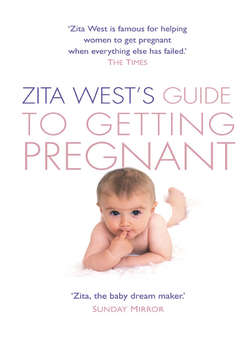Читать книгу Zita West’s Guide to Getting Pregnant - Zita WEST, Zita West - Страница 34
The Magnificent Egg
ОглавлениеThe ovum, or egg, is the largest cell in the body – 550 times bigger than the sperm. As it matures within its fluid – filled follicle prior to ovulation, it needs a lot of energy, which is supplied by the granulosa cells (specialized cells in the ovary). These cells have two functions: to secrete oestrogen (to help the egg mature) and to nourish and feed the egg as it grows.
The maturing egg is now suspended in a fluid – filled cavity (sometimes referred to as the graafian follicle, after the scientist who first discovered it). This follicle measures about 18–23mm just prior to ovulation, and when ovulation – the release of the egg – occurs, the follicle bursts and the mature egg is released into the Fallopian tube.
There are an estimated 7 million granulosa cells packed around an egg, greatly increasing the availability of energy. When the egg is eventually released, it takes with it a mass of these cells, giving it a ‘sunburst’ appearance. These cells also serve to protect and nourish the egg on its journey, and will provide a barrier against all but the one sperm that will fertilize it.
The hormonal stimulus for ovulation is the rise of oestrogen, and the primary factor that determines when you will ovulate is the level of oestrogen getting to a certain threshold, which creates a surge in luteinizing hormone (LH), responsible for the rupture of the follicle and release of the egg. So anything that depletes oestrogen will keep it from reaching the necessary level, and ovulation will not take place.
Ovulation also won’t occur unless the optimum level of oestrogen is maintained for the correct length of time. The timing of ovulation is quite exact, occurring about 36 hours after the surge in LH. Only a mature egg, once fertilized, will result in conception. Immature eggs are unlikely to be capable of being fertilized, and even if they are they tend to produce an abnormal embryo that won’t implant or develop properly, resulting in an early miscarriage (before 12 weeks). So it’s very important that the level of oestrogen produced accurately reflects the egg’s maturity. It’s a delicate feedback process, and the timing is crucial. A mature egg is necessary for fertilization because only then will it have chromosomes at the right stage for further development, allowing one sperm in and blocking the rest, and ensuring that the egg and sperm fuse properly.
At the same time, just before ovulation the follicle generates a rapid rise in the hormone progesterone. The rise in progesterone also keeps the FSH secretion going just long enough to allow full maturation of the follicle. As the hypothalamus is shutting down on FSH secretion, it is releasing prostaglandins to the follicle just before it ruptures. It is thought that these prostaglandins may help to expel the egg by breaking down the follicle wall.
Once the egg is released, the resulting cavity and the remaining granulosa cells start to produce more progesterone. These cells also stain the ruptured follicle an orangey – yellow colour, giving rise to the name corpus luteum, from the Latin for ‘yellow body’.
The egg is at its most susceptible to nutrient deficiency during this phase of the menstrual cycle, leading up to ovulation where the egg is maturing, and during early embryonic life (the first 30 days after conception). Research shows that a 70 per cent increase in sensitivity to toxins, alcohol and smoke occurs between 11.30 a.m. and 7 p.m. on the day preceding ovulation. In the five days prior to ovulation a good diet and as few toxins as possible are particularly important for achieving pregnancy. Also, it is not wise to drink heavily during this phase of your cycle. If the diet is too low in proteins, for example, too few eggs may ripen, while a vitamin B1 deficiency can inhibit ovulation. Because it can be difficult to gauge exactly when ovulation occurs, however, it is always wise to maintain good nutrition throughout your cycle.
